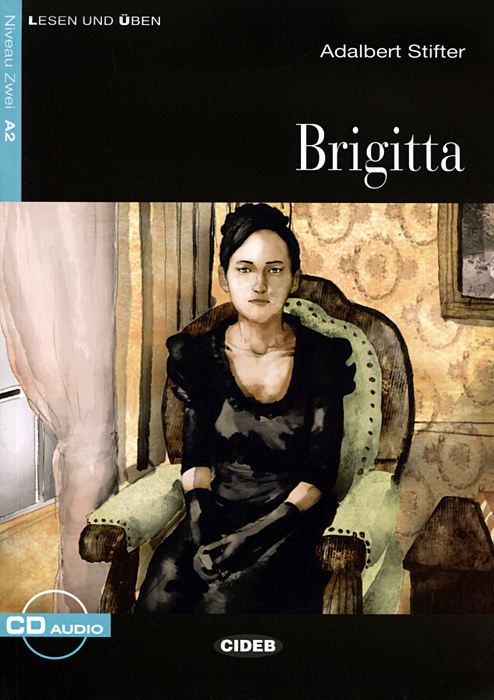Книга: Adalbert Stifter «Brigitta: Niveau Zwei A2 (+ CD)»

|
Серия: "Lesen und Uben" Sein Freund, der Major, fuhrt ein zufriedenes Leben auf dem Land. Er arbeitet den ganzen Tag, er trifft Freunde und diskutiert Liber Reformen. Aber es gibt keine Liebe in diesem Leben. Oder doch? Wer ist Brigitta, die Nachbarin, die dort frei auf ihrem Bauernhof Iebt? In dieser Novelle fiihrt Adalbert Stifter einen neuen Frauentyp in die deutschsprachige Literatur ein: die ungebundene, beruflich erfolgreiche Frau, die ohne Mann leben kann. Издательство: "Cideb" (2010) Формат: 150x210, 96 стр.
ISBN: 9788853009821, 978-88-530-0982-1 Купить за 759 руб на Озоне |
Adalbert Stifter
Adalbert Stifter (
Adalbert Stifter.
Instead of becoming a state official, he became a
Stifter visited
His physical and mental health began to decline in 1863, and he became seriously ill from cirrhosis of the liver in 1867. In deep depression, he slashed his neck with a razor on the night of
Stifter's work is characterized by the pursuit of beauty; his characters strive to be moral, and move in gorgeous landscapes luxuriously described. Evil, cruelty, and suffering rarely appear on the surface of his writing, but
The majority of his works are long stories or short novels, many of which were published in multiple versions, sometimes radically changed.
Stifter's "
"
He was named as an influence by
Works
* "
* "
* "
* "
* "
* "
** "
** "
** "
** "
** "
** "
* "
* "
* "
* "
* "
* "
** "
** "
** "
** "
** "
** "
* "
* "
* "
* "
* "
* "
References
*
*
*
External links
* [http://www.pushkinpress.com PushkinPress.com] English editions of works by the author
* [http://www.adalbertstifter.at/ Adalbert Stifter website]
*
*
Источник: Adalbert Stifter
Другие книги схожей тематики:
| Автор | Книга | Описание | Год | Цена | Тип книги |
|---|---|---|---|---|---|
| Adalbert Stifter | Brigitta: Niveau Zwei A2 (+ CD) | Sein Freund, der Major, fuhrt ein zufriedenes Leben auf dem Land. Er arbeitet den ganzen Tag, er trifft Freunde und diskutiert Liber Reformen. Aber es gibt keine Liebe in diesem Leben. Oder doch? Wer… — Cideb, (формат: 150x210, 96 стр.) Lesen und Uben Подробнее... | 2010 | 759 | бумажная книга |
См. также в других словарях:
Didaktik der Musik — Das Buch Didaktik der Musik von Michael Alt beinhaltet die erste in der Bundesrepublik Deutschland entstandene musikdidaktische Konzeption. Über Alts Konzeption schreibt Brigitta Helmholz: Wie sehr Alts Konzeption die deutsche Musikpädagogik… … Deutsch Wikipedia
Georges Simenon — Georges Simenon, 1963, Foto von Erling Mandelmann Georges Joseph Christian Simenon (* 12. Februar 1903[1] in Lüttich; † 4. September 1989 in Lausanne) war ein belgische … Deutsch Wikipedia
Nordseefischen — Die Nordsee ist ein durchschnittlich 94 Meter tiefes Randmeer des Atlantischen Ozeans im nordwestlichen Europa. Das Schelfmeer ist auf drei Seiten von Land begrenzt und öffnet sich trichterförmig zum nordöstlichen Atlantik. In einem 150 Kilometer … Deutsch Wikipedia
Nordseeküste — Die Nordsee ist ein durchschnittlich 94 Meter tiefes Randmeer des Atlantischen Ozeans im nordwestlichen Europa. Das Schelfmeer ist auf drei Seiten von Land begrenzt und öffnet sich trichterförmig zum nordöstlichen Atlantik. In einem 150 Kilometer … Deutsch Wikipedia
Brigittenau — 0020XX . Wiener Gemeindebezirk Wappen Karte … Deutsch Wikipedia
Nordsee — Die Nordsee ist ein durchschnittlich 94 Meter tiefes Schelfmeer am Rand des Atlantischen Ozeans im nordwestlichen Europa. Bis auf die Meerengen beim Ärmelkanal und beim Skagerrak auf drei Seiten von Land begrenzt, öffnet sich das Meer… … Deutsch Wikipedia
